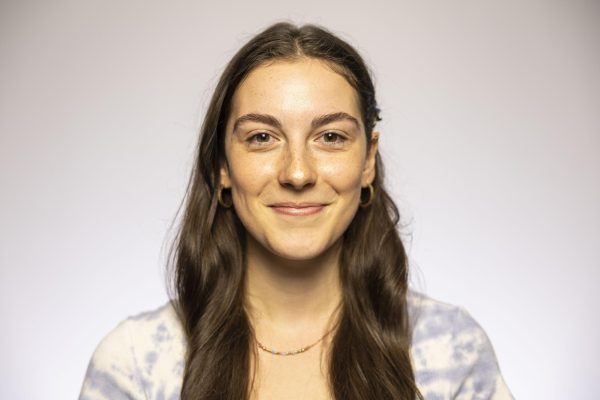Public Space One hosts Juan Correa’s ‘Los Performers’ exhibit in North Gallery
From April 1-29, Public Space One is hosting ‘Los Performers,’ an exhibit by artist and printmaker Juan Correa that explores the intersections of his experiences with American and Latinx cultures.
The piece titled “Una Coz En Mi Cabeza” is shown in the back room at the Los Performers by artist Juan Correa gallery at Public Space One on Friday, April 21, 2023. The gallery hours are Friday from 4-6 pm and Saturday from 12-3 pm. The final day of the show will be Friday, April 28, 2023. (Averi Coffee/The Daily Iowan)
April 25, 2023
Juan Correa was born in Bogota, Columbia, and grew up in Los Angeles, California. In his “Los Performers” exhibit, Correa said he explores his experiences and interactions with American and Latinx cultures through depictions of significant childhood moments.
From April 1-29, Public Space One is presenting Correa’s “Los Performers” exhibition in the gallery space at 229 N. Gilbert Street.
Correa is an artist and printmaker in Iowa City. He received his Bachelor of Science in studio art from Skidmore College and earned his Master of Arts and Master of Fine Arts from the University of Iowa’s Printmaking program. His work has since been internationally exhibited.
After May 2022, Correa received PS1’s Fall 2022 Free Studio Residency and has since reconnected with PS1 for his “Los Performers” exhibit.
Many of the prints in the exhibit feature the outlines of figures that look like echoes of people or ghostly presences. While one young boy typically appears to be the focus of each piece, he is surrounded by other children who are drawn with skeletal faces.
Correa’s haunting and vulnerable work may require time to fully absorb because it contains deeper meanings and symbolism that Correa literally and figuratively spotlights with graphite shading.
“I use a spotlight in my images to shed light on several themes: coping mechanisms, anxieties over the unknowns, harkening on decisions made, and reflections on change and their relation to self-perception,” Correa wrote in his statement about the exhibit on PS1’s website.
Student Halley Brocker, currently seeking a master’s in social work from the UI, observed the spotlights on a particular piece called “Como con Comido” while visiting the exhibit.
“I like that there are spotlights, and it’s kind of dark,” Brocker said. “They’re focused, each of them. One’s bigger, and one’s smaller.”
Brocker’s friend Rachel Studer also appreciated the prints and emphasized the importance of supporting artists.
“I like looking at art and supporting the people that make it,” Studer said. “It’s a lot of effort and time, and it only takes like three seconds to look at something and support it.”
Correa spent time working on this exhibit during his time at the UI and after he graduated, according to PS1 artist resource manager Hannah Givler. This exhibit that reflects on growth from childhood has grown with Correa over at least a one-year-long period.
Having known Correa since his fall residency, Givler admires his artistic ambition. This ambition was supported by an Artist Catalyst Grant that he received from the Iowa Arts Council to help fund the “Los Performers” exhibit.
Artist Catalyst Grants are awarded to artists, filmmakers, musicians, and creative writers in Iowa City applying to elevate a certain creative project. The grant’s funds cover expenses essential to the project’s development.
Givler said she hopes people can find a point of relation or connection to Correa’s artwork as she did. She was particularly intrigued by Correa’s linework and the way he made every object in his prints feel spacious and ascendant.
“I hope that they find some relationship with the work, and through looking at the work, they find more understanding for themselves and for the perspective of the artist, too,” Givler said. “That by looking at the work, they might learn something more about both things and their own inner life because I think it does touch all of us.”















